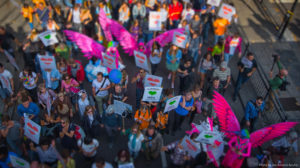On December 15, 2014, Invisible Children announced that they are ending their programs in the United States and handing the reins and remaining funds to their regional partners in Uganda and surrounding areas affected by the Lord’s Resistance Army. Invisible Children is best known for producing the half-hour documentary Kony 2012, which thrust the organization into the national and international spotlight in March 2012. The viral video garnered praise and a heap of donations, nearly twice as much as the organization raised in 2011, but also an avalanche of criticism.
Kony 2012 was a viral phenomenon, no doubt about it. But what went largely unacknowledged in the explosion of media coverage around the film and the organisation was the existing base of supporters who helped spread the video. These were mostly high school and college students recruited through Invisible Children’s Roadie program, a recruitment and awareness-building strategy based on peer to peer connections. The success of the 2012 film obscured years of work that went into grassroots organising. Although Invisible Children will always be known, for better or worse, as the organisation that made Kony 2012, they should also be remembered for their ability to mobilise thousands of young Americans around their cause.

Map depicting the network connections underlying Kony 2012 conversation. Pre-existing on-the-ground networks drove conversation from places largely disconnected from high profile celebrities. Visualization by Gilad Lotan, SocialFlow.
The Rough Cut
When Margie Dillenburg first met the would-be founders of Invisible Children, Jason Russell, Laren Poole, and Bobby Bailey, she was a teacher and school administrator in San Diego, California. Dillenburg was living in an apartment with a couple other girls, one of whom was engaged to Russell. When Russell, Poole and Bailey were editing their first film, they’d often crash at Dillenburg’s apartment.
In 2004, Dillenburg attended the first screening of Invisible Children: The Rough Cut. Although they had set out to document the violence in Sudan, the three young filmmakers stumbled upon the night commuters: children who walked from their rural homes to safe spaces in town centers every night to avoid being abducted by Joseph Kony’s Lord’s Resistance Army and forced to become child soldiers.
Dillenburg immediately felt compelled to get involved in some way. She saw the emotional response the film provoked in the audience and thought to herself, “these people are going to be worse off if we don’t provide them constructive engagement.”
Dillenburg was one of Invisible Children’s first two employees, along with Ben Keesey. He was put in charge of the money; Dillenburg was tasked with spreading the word about the film and the cause and figuring out what to do with people who wanted to get involved. Meanwhile, Russell, Poole and Bailey went off to make another film.
From the beginning, Dillenburg recalls, when Russell, Poole and Bailey were asked “What can I do?” they would respond, “What do you do?” and then add “Do that.” So when Dillenburg first signed on with Invisible Children she drew on her experience in schools. “I was like, ‘I know schools, I’ll go to schools.’” And that was how she came to develop the Roadie model shortly after the organisation was founded.
Her general advice to organisers looking to recreate Invisible Children’s success is not to try to replicate their team or their talents, but to make use of the talents and skills of the existing team.
The Roadie Model
The Roadies were Invisible Children’s ambassadors. Hired in two batches, one for the fall semester and one for the spring, they were trained for a month at the headquarters in San Diego and then sent out in groups to different regions of the country to visit high schools and colleges, encourage students to start clubs, to raise money and to participate in coordinated awareness-raising campaigns (more on those later).

Roadies in training gathered together at Invisible Children headquarters on Thanksgiving, 2013.
Roadies had to be high school graduates 18 years of age or older, and possess a driver’s license and a good driving record. Most Roadies were looking to take a gap year before, during or just after college. They were not paid. In fact, Dillenburg says that Roadies had to fundraise $1,500 before the program even began, most of which was given back to them to cover their expenses and self-care on the road. Invisible Children provided housing in San Diego during training, but once on the road Roadies would stay with the organization’s contacts, crashing on couches.
During the month at headquarters, Roadies would train for the first half of the day—learning the history of Invisible Children, of Joseph Kony and the Lord’s Resistance Army, of the colonization of Africa—and spend the latter half booking events at schools. They had a quota to fill, 50 screenings or so, Dillenburg says. Roadies were motivated to fill the quota as soon as possible. A big launch party was held at the end of the month and those who did not fill their quota stayed behind as others went out on the road.
Some Roadies stayed on for a second semester. At first they were all trained to spot students who might make a good Roadie, but Dillenburg says that after the second year they no longer had to recruit. They would just send out the application and have a solid pool from which to choose.
Crafting Actions for Empowerment (and Sharing)
Part of a Roadie’s responsibilities was recruiting participants for large-scale, cross-country fundraising and awareness-raising events. In 2006, Invisible Children organised their first national event, Global Night Commute, in 125 US cities. They estimate 80,000 teens and twenty-somethings participated, walking from their club meeting places to city centers “in solidarity with the night commuters in Uganda.”

Thousands gather in Portland, Oregon, for Global Night Commute. April 29, 2006. Photo by Nathaniel Rinehart, Flickr.
“The day after we thought ‘yay, it’s over,’” Dillenburg recalls. “Naively we thought one event would end the war.”
Surprise: it didn’t. Invisible Children continued to organise large events across the country through the efforts of Roadies and the youths they recruited, drawing more and more attention to their cause.
The second national event was meant to raise awareness about displacement camps. Dillenburg says “we had people stay in field overnight, build cardboard villages, to understand—not to understand because you could never fully understand the experience of a displaced person—but…to do it in solidarity.”
Roadie-organized events across the U.S. raised awareness and engaged supporters by giving them tangible opportunities to meet and make their voices heard.
Nationwide events typically happened in April and played a key role in Congressional lobbying. Participants wrote individual letters to their Members of Congress at these events. Roadies and other organisers then recruited participants from across the United States to join a Congressional “Lobby Day” in late-Summer or Fall. Hundreds – eventually thousands – of people visited Congressional offices during these DC lobbying blitzes.
In 2006, the year of the Global Night Commute pictured above, over 600 people met with Congressional staff. Shortly thereafter, dozens of Members of Congress signed a letter calling for a diplomatic envoy to Uganda who was subsequently appointed.
Over 1,500 people participated in a 2009 Lobby Day that helped generate over 70 bill cosponsors in just one day. Eventually, that bill had more cosponsors than any other Africa-focused legislation in U.S. history, later passed and was signed into law by President Obama in 2010.
Invisible Children events were also crafted with video in mind. Actions were experiential, outdoors, and, like the 2007 Displace Me event shown in the video below, were colorful and crowd-driven. Roadies and other organisers understood that photos and video let participants share their excitement and could be used to help share the Invisible Children story with thousands more people in schools and other presentations.
For a 2009 event called “The Rescue,” Invisible Children’s satellite groups camped out at designated locations until they were “rescued” by a celebrity or politician. After one location was “rescued” many of the participants would hop on buses and drive to another city that hadn’t been rescued yet. Eventually everyone landed in Chicago, outside Oprah Winfrey’s studio, and she shared their message.
Kony 2012 was an invitation to a similar coordinated action, “Cover the Night,” which was supposed to make Joseph Kony a household name. Dillenburg had resigned from her post at Invisible Children just before Kony 2012 blew up, but as she puts it: “Cover the Night was supposed to be the pinnacle event, but Kony 2012 was the pinnacle…it took the authenticity out of the event.”
It also made it seem like their call to action was a complete failure, the flop of an untried and untested organisation, a story the media spread without any acknowledgement of their previous successes. This Guardian article, for example, suggests they just weren’t able to bring online mobilizing to the streets. It doesn’t point out that the success of the film made the action redundant.
The Messages and Smart Tools that Tie Together an “Underground” Network
Invisible Children had a few carefully curated forces working in their favor: the peer to peer element, the “cool” factor, and a strong network. Salesforce, a constituent relationship management database, was used to track the network, Roadies and their outreach activities.
The peer to peer component and the “cool” factor go hand in hand. The advantage of sending Roadies—generally recent college or high school graduates—to high schools and colleges to recruit is to show students that they have a place in the organisation, that they could be in a position to make a difference, to spread the word. If the Roadies seem like they’re having fun, the students they’re recruiting want to get in on it.

People walk across the Brooklyn Bridge during The Rescue event in 2009. The Rescue asked attendees to “abduct themselves for the abducted” until they were publicly rescued by a celebrity or media figure.
Beyond the appeal of a pitch coming from someone you simultaneously admire and can easily relate to, Invisible Children also cultivated a cool and hip image. Dillenburg suggests this was happenstance: “Looking back, I don’t know how we did it,” Dillenburg says. “We just were who we were, we loved each other, and we weren’t trying to be relevant…we just did what we thought was cool.”
Lisa Dougan picked up on the “underground feel” of Invisible Children. Dougan became a student activist after an early Roadie tour stopped by her college, where Dillenburg’s father was a professor. After graduation Dougan herself became a Roadie, and was eventually brought on staff as a tour manager. She is now the Director of International Programs at Invisible Children.
Joining Invisible Children, Dougan says, “felt like you were handed a secret…that you’re part of a network.”
The films reinforce that sense of belonging. Dougan explains that every Roadie tour has a purpose, whether it is fundraising or a “policy campaign with one big-name political ask that we’re trying to rally people behind.” Films both present the “ask”—as Kony 2012 did with “Cover the Night,” and tout the organisation’s previous successes, so that student activists can see the results of their labor.
“Looking back, I don’t know how we did it. We just were who we were, we loved each other, and we weren’t trying to be relevant…we just did what we thought was cool.”
– Margie Dillenburg
Michael Poffenberger, co-founder of The Resolve, Invisible Children’s political advocacy partner, noted that involvement with Invisible Children introduced thousands of young people to community activism. He points to results of a 2008 Invisible Children supporter survey in which 75% of respondents said they were not involved with other causes as an indicator that the peer-to-peer model and “cool” factor engaged students who wouldn’t have otherwise been part of any activist causes. Over time, this helped generate new social capital as young people got involved in politics and social change — and stayed involved over time.
Everyone is Valuable
One challenge with relying so heavily on student activists and young, temporary laborers is a high turnover rate. To keep their relationships at schools strong, the organization began using Salesforce to log calls and emails. Dillenburg describes it as “basically a giant database for all of our Roadie activities.”
“It is drilled into their [Roadie’s] brain that every single activist that gets involved with us is a precious gem,” explains Dougan, “and it is your responsibility to make sure that person is celebrated and thanked…and you document who you met and you need to keep that info for the next Roadie.”
Questions and Criticism Follow Kony 2012
Although much of the backlash against Invisible Children and Kony 2012 was unnecessarily vicious and sometimes unfounded bilge, other criticisms were reasonable and fair, and I repeat some of them here so as to examine the connections between these valid concerns and Invisible Children’s advocacy model.
Researcher danah boyd was one of the few commentators on Kony 2012 who credited Invisible Children’s existing networks for their viral success. However, she wrote that she was “really bothered” that Kony 2012 is a campaign about white people deciding what should be done about “poor black people” in Africa.
“The fact that privileged folks — including white American youth — can spread messages like this is wonderful,” boyd writes, “but my hunch is that they’re structurally positioned to spread information farther and wider than those who are socially marginalized. What happens when they try to speak out on behalf of marginalized voices instead of helping marginalized voices be heard?”
Teju Cole characterized their work as being a part of the “white-savior industrial complex.”
Invisible Children was also criticized for their oversimplification of a complex issue.
In Ethan Zuckerman’s post “unpacking” the video, he expresses both admiration and distaste for their strategy:
While I resent the emotionally manipulative video Invisible Children have produced, I admire the craft of it. They begin with a vision of a changing global world, where social media empowers individuals as never before. They craft a narrative around a passionate, driven advocate – Jason Russell – and show us the reasons for his advocacy – his friendship with a Ugandan victim of Kony. The video has a profound “story of self” that makes it possible for individuals to connect with and relate to. And Invisible Children constructs a narrative where we can help, and where we’re shirking our responsibility as fellow human beings if we don’t help.
Zuckerman wonders if simplicity is a prerequisite for successful attention-based advocacy, and if so, “are we forced to engage only with the simplest of problems? Or to propose only the simplest of solutions?”
These two problems (privilege; over-simplification) are built into Invisible Children’s Roadie model, which relies on wealthy (wealthy enough to take a full-time, unpaid job for months at a time) Americans spreading a message and a campaign that can be summed up in a 30 to 50-minute video. And, as Zuckerman points out, there are the limits of attention-based advocacy, although the Roadie model could conceivably be used to promote and develop other kinds of activism.
Sustaining the Roadies Program
Although Invisible Children demonstrated a remarkable ability to maintain networks at schools across the country, relying on young activists who (generally) move on to other projects or employment is inherently a fragile system, one that could be improved on.
“One thing we did wrong,” Dillenburg says, “is that we didn’t grow in maturity with our audience, so a lot of people we got in high school are now young professionals, and we didn’t keep that line going.”
Another potential weakness in terms of sustainability is relying on unpaid labor. Although 57 percentof non-profit internships are unpaid, the difficulty of finding paid employment can deter recent graduates from pursuing a career in that field. Framing the Roadie position as an ideal “gap year” gives the impression that this kind of work is temporary, something you do before finding a real job. Obviously, this is not always the case, as many Roadies, including Lisa Dougan, stayed in the field (or even grew into leadership roles at Invisible Children), but it is something to consider.
One of the criticisms of Invisible Children was that only 32 percent of their income went to direct services, with the remainder going to staff salaries, travel, and film production (though over 80% of all funds were spent on programs including advocacy and education in the U.S. that leveraged millions in American investment in and support for related Uganda-based projects). Like many organisations that rely on donations, they may not have been in a hurry to spend more money on staffing.
End of an Era
Although Invisible Children is only officially closing up shop now, they’ve been winding down ever since Kony 2012broke their mobilisation model. Although Dillenburg had already left the organisation by then, she was still unofficially involved. She explains why the Roadie model just didn’t really work after Kony 2012.
“We couldn’t get into schools anymore, and schools before were our bread and butter,” she says. “Invisible Children became controversial, and schools don’t like controversy.”
On top of that, their target demographic lost interest. “Millennials like to discover things,” says Dillenburg, “and [Invisible Children/Kony] was already discovered. Everyone had heard about it, so it just became boring.”

Members of the “Middle America Roadie team” at Excelsior Middle School in Marion, Iowa. 2012.
In a recent interview with GOOD, Ben Keesey said, on the subject of cynicism:
“To all of the folks that said to all the youth supporters of the Kony campaign, This isn’t going to do anything, this is slacktivism, this isn’t actually going to affect peoples’ lives,” [I say] that is just patently untrue. I think it’s our job to draw straight lines between peoples’ energy and results. When you can do that, it’s super powerful. When you can harness the young peoples’ unique capacity for outrage and give them tangible actions that lead to specific results. It’s an incredible, powerful model that absolutely combats that cynical nature and culture.
Although it has weaknesses, the Roadie model is a powerful one, one that other organisers can and should learn from and adapt to their purposes.
Read More
- Values, story and strategy: Breaking down why Invisible Children’s Kony campaign hooks people (Mobilisation Lab)
- [Data Viz] KONY2012: See How Invisible Networks Helped a Campaign Capture the World’s Attention (Gilad Lotan)
Top photo: During The Rescue, supporters demonstrated outside Oprah Winfrey’s Chicago studio for six days until she agreed to bring them on her show. Courtesy Invisible Children, Flickr.
Categories:
organising, mobilising and engagement




